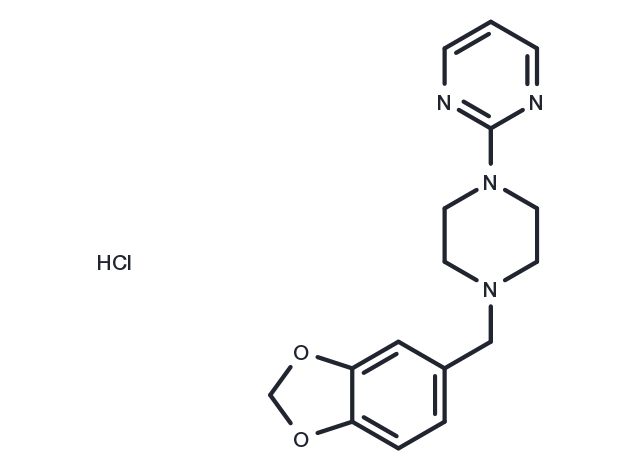Powder: -20°C for 3 years | In solvent: -80°C for 1 year


Piribedil hydrochloride can be used in the parkinson's disease, circulatory disorders, cancers research. Piribedil hydrochloride inhibits MLL1 methyltransferase activity with EC50 value of 0.18 μM. Piribedil hydrochloride is a potent and orally active agonist of dopamine D2 and dopamine D3 as well as the antagonist of α2-adrenoceptors [1] [2] [3] [4].

| Pack Size | Availability | Price/USD | Quantity |
|---|---|---|---|
| 25 mg | 6-8 weeks | $ 1,520.00 | |
| 50 mg | 6-8 weeks | $ 1,980.00 | |
| 100 mg | 6-8 weeks | $ 2,500.00 |
| Description | Piribedil hydrochloride can be used in the parkinson's disease, circulatory disorders, cancers research. Piribedil hydrochloride inhibits MLL1 methyltransferase activity with EC50 value of 0.18 μM. Piribedil hydrochloride is a potent and orally active agonist of dopamine D2 and dopamine D3 as well as the antagonist of α2-adrenoceptors [1] [2] [3] [4]. |
| In vitro | Piribedil hydrochloride, at concentrations ranging from 0 to 160 μM over 7 days, specifically targets and inhibits MLL1 methyltransferase activity while also selectively suppressing the proliferation of MLL-r cells, as indicated by cell proliferation assays on MLL-r AML cells (THP-1 and MV4;11) and a non-MLL leukemia cell line (K562). This compound, over a 4-day period at the same concentrations, not only selectively reduces H3K4 methylation in MLL-r cells by disrupting the MLL1-WDR5 interaction but also prompts cell-cycle arrest, apoptosis, and differentiation in these cells. Western blot analysis further reveals a concentration-dependent decrease in H3K4me2 and H3K4me3 levels, without affecting other histone methylation sites such as H3K79, H3K36, and H3K27, showcasing its selectivity and potential therapeutic implications in treating MLL-r leukemia. |
| In vivo | Piribedil hydrochloride, administered through intraperitoneal injection at doses of 5, 15, and 40 mg/kg, effectively mitigates L-DOPA-induced dyskinesias in a rat model of Parkinson’s disease. When given orally at a dosage of 4-5 mg/kg daily for two weeks, it enhances locomotor activity and reverses motor deficits in adult common marmosets. Additionally, a higher concentration of 150 mg/kg administered daily for 21 days via oral gavage has been shown to inhibit MLL-r tumor growth and reduce expression levels of MLL1 target genes in MV4;11 tumor xenografts. Studies revealed a reduction in turning behavior and various forms of dyskinesia in rats, with an increase in locomotive dyskinesias observed at the 40 mg/kg dosage. In marmosets, there was an increase in vigilance and alertness along with the reversal of downregulated preprotachykinin mRNA in the striatum, indicating improvements in motor and neurological functions. |
| Molecular Weight | 334.8 |
| Formula | C16H19ClN4O2 |
| CAS No. | 78213-63-5 |
Powder: -20°C for 3 years | In solvent: -80°C for 1 year
You can also refer to dose conversion for different animals. More
bottom
Please see Inhibitor Handling Instructions for more frequently ask questions. Topics include: how to prepare stock solutions, how to store products, and cautions on cell-based assays & animal experiments, etc.
Piribedil hydrochloride 78213-63-5 inhibitor inhibit
